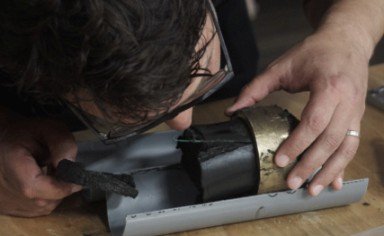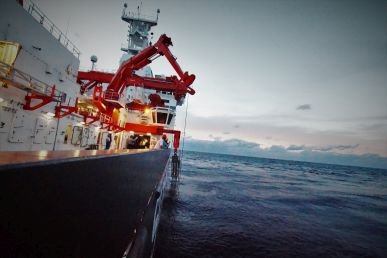Earthquake Archive in the GEological Record of the Japan Trench (EAGER-Japan)
Austrian Science Fund (FWF) - (2016-2021)
Project number P29678-N28
PI Michael Strasser
Project members: Arata Kioka, Pauline Cornard (Postdocs) & Tobias Schwestermann (PhD Student)


Project collaborators:
Jasper Moernaut (University of Innsbruck)
Achim Kopf (MARUM, University of Bremen)
Toshiya Kanamatsu (Japan Agency for Marine-Earth Science and Technology - JAMSTEC)
Shuichi Kodaria (Japan Agency for Marine-Earth Science and Technology - JAMSTEC)
Ken Ikehara (Geological Survey of Japan)
Tim Eglinton (ETH Zürich)
Cecilia McHugh (Queens College, New York)
Master-students associated to the EAGER Japan Project:
Jana Molenaar, Dominik Jeager, Jonas Keller,
Publications:
- Kioka, A., Schwestermann, T., Moernaut, J., Ikehara, K., Kanamatsu, T., Eglinton, T.I. & Strasser, M. (2019). Event Stratigraphy in a Hadal Oceanic Trench: The Japan Trench as Sedimentary Archive Recording Recurrent Giant Subduction Zone Earthquakes and Their Role in Organic Carbon Export to the Deep Sea. Frontiers in Earth Science, https://doi.org/10.3389/feart.2019.00319
- Kioka, A., Schwestermann, T., Moernaut, J., Ikehara, K., Kanamatsu, T., McHugh, C.M., dos Santos Ferreira, C., Wiemer, G., Haghipour, N., Kopf, A.J., Eglinton, T.I., Strasser, M. (2019) Megathrust earthquake drives drastic organic carbon supply to the hadal trench. Nature Scientific Reports, 9, 1553. https://doi.org/10.1038/s41598-019-38834-x
- Jaeger, D., Stalder, R., Masago, H., & Strasser, M. (2019). OH defects in quartz as a provenance tool: Application to fluvial and deep marine sediments from SW Japan. Sedimentary Geology, 388, 66–80. https://doi.org/10.1016/j.sedgeo.2019.05.003 online article
- Lackey, J., Moore , G., Strasser, M. (2018) Three-dimensional mapping and kinematic characterization of mass transport deposits along the outer Kumano Basin and Nankai accretionary wedge, southwest Japan. Progress in Earth and Planetary Science, 5:65, https://doi.org/10.1186/s40645-018-0223-4
- Lackey, K., Moore, G. F., Strasser, M., Kopf, A., Ferreira, C.S. (2018) Spatial and temporal cross-cutting relationships between fault structures and slope failures along the outer Kumano Basin and Nankai accretionary wedge, SW Japan. Geological Society of London, Special Publications, 477, https://doi.org/10.1144/SP477.10
- Molenaar, A., Moernaut, J., Wiemer, G., Dubois, N., & Strasser, M. (2019). Earthquake Impact on Active Margins: Tracing Surficial Remobilization and Seismic Strengthening in a Slope Sedimentary Sequence. Geophysical Research Letters, 41(11), 1195. https://doi.org/10.1029/2019GL082350
- Schwestermann, T., Huang, J., Konzett, J., Kioka, A., Wefer, G., Ikehara, K., Moernaut, J., Eglinton, T., Strasser, M. (2020). Multivariate statistical and multi‐proxy constraints on earthquake‐triggered sediment remobilization processes in the central Japan Trench. Geochemistry, Geophysics, Geosystems, 2020 https://doi.org/10.1029/2019GC008861
-
Schwestermann, Tobias; Eglinton, Tim, I.; Haghipour, Negar; McNichol, Ann, P.; Ikehara, Ken; Strasser, Michael (2021); Event-dominate transport, provenance and burial of organic carbon in the Japan Trench. Earth and Planetary Science Letters, 563, 116870, https://doi.org/10.1016/j.epsl.2021.116870
- Strasser, M., Ikehara, K., and Cotterill, C., 2019. Expedition 386 Scientific Prospectus: Japan Trench Paleoseismology. International Ocean Discovery Program. https://doi.org/10.14379/iodp.sp.386.2019
- Strasser, M. et al. Report and preliminary results of R/V SONNE cruise SO251, Extreme events Archived in the GEological Record of Japan’s Subduction margins (EAGER-Japan), Leg A SO251-1, Yokohama - Yokohama, 04.10.2016 – 15.10.2016, Leg B SO251- 2, Yokohama - Yokohama, 18.10.2016 – 02.11.2016. Berichte, MARUM – Zentrum für Marine Umweltwissenschaften, Fachbereich Geowissenschaften, Universität Bremen, 318, 1–217, http://publications.marum.de/id/eprint/3677 (2017)
Presentations and Webinars:
Seds Online Webinar 21.10.2020 by Michael Strasser
